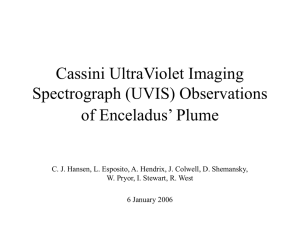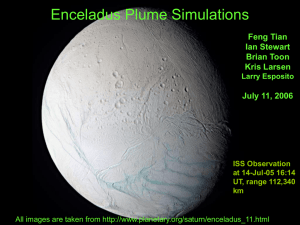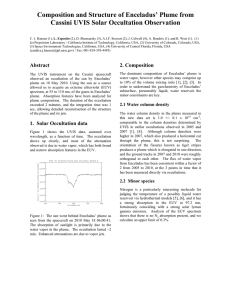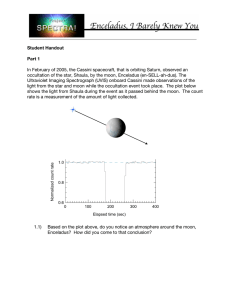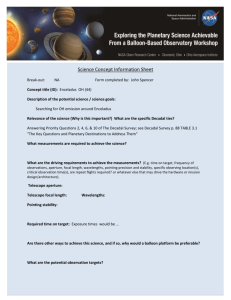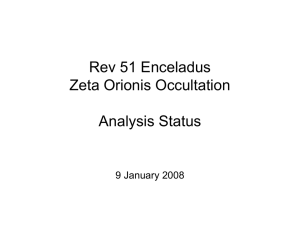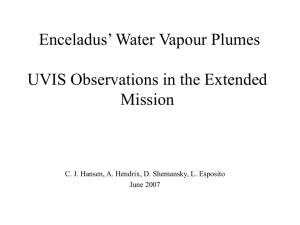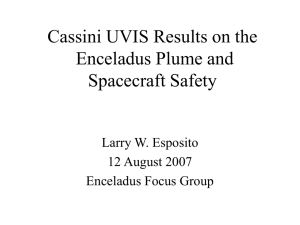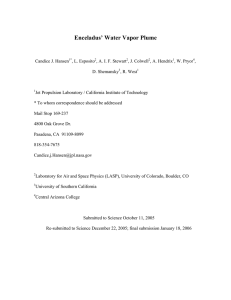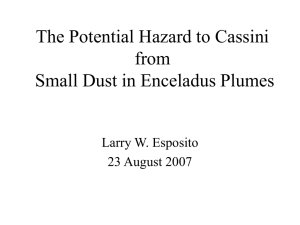Cassini UltraViolet Imaging Spectrograph (UVIS) Observations of Enceladus’ Plume
advertisement
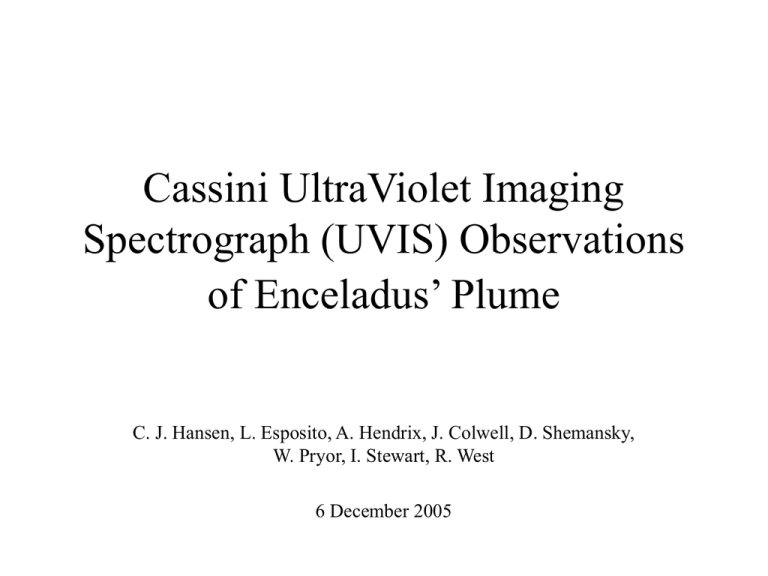
Cassini UltraViolet Imaging Spectrograph (UVIS) Observations of Enceladus’ Plume C. J. Hansen, L. Esposito, A. Hendrix, J. Colwell, D. Shemansky, W. Pryor, I. Stewart, R. West 6 December 2005 Summary of Results The occultation of Gamma Orionis July 14 observed by UVIS during the third close Enceladus flyby has led to the following results: • Confirmation of the existence and composition of Enceladus’ plume – Water vapor fits the absorption spectrum best • Near surface abundance (line of sight) = 1.5 x 10 16 cm-2 – Upper limit for CO abundance ~ 1% of water column density • Localization of Enceladus’ plume – Enceladus’ “atmosphere” is not global, it has only been detected near the south pole • Gas absorption features were not detected on the ingress or egress of the Lambda Sco occultation in February 2005 • Gas absorption features were detected on the ingress but not the egress of the gamma Orionis occultation • The water budget derived from the water vapor abundance is adequate to supply most if not all of the OH detected by HST, atomic oxygen in the Saturn system detected by UVIS, and to re-supply Saturn’s E ring UVIS Characteristics UVIS has 4 separate channels: • Far UltraViolet (FUV) • 110 to 190 nm • 3 slit widths => 2.8, 4.8, 24.9 nm spectral resolution • 2D detector: 1024 spectral x 64 onemrad spatial pixels • Extreme UltraViolet (EUV) • 55 to 110 nm • 3 slit widths => 2.8, 4.8, 19.4 nm spectral resolution • 2D detector: 1024 spectral x 64 onemrad spatial pixels • Solar occultation port • High Speed Photometer (HSP) • 2 or 8 msec time resolution • Hydrogen – Deuterium Absorption Cell (HDAC) For the occultations we used the • HSP with 2 msec time resolution • FUV with 512 spectral channels (1.56 nm resolution), 5 sec integration time Occultation Geometries Lambda Scorpii Occultation Gamma Orionis Occultation Egress Ingress Detection of Plume: High Speed Photometer (HSP) vs. Time • Clear indication of attenuation of signal during occultation ingress; egress is signature of HSP warmup • Start to sense atmosphere ~24 sec prior to hard limb occultation • Ray height at –24 sec is ~ 155 km FUV Data: Comparison of Occulted to Unocculted Spectra FUV configuration: • spectral channels binned by 2 (512 spectral channels from 113.5 nm to 191 nm) • low resolution slit width • 5 sec integration time • full spatial resolution Time record 33, the last full 5 sec integration prior to ingress, shows the deepest absorption. The ray altitude above Enceladus’ surface corresponding to time record 33 ranged from 30 to 7 km. Clear signature of an atmosphere is present – both relatively narrow and broad absorption features Composition of Plume is Water Vapor I=I0 exp (-n*) I0 computed from 25 unocculted samples n = column density = absorption cross-section The absorption spectrum of water (pink line) is shown compared to Enceladus’ plume spectrum (I/I0) for a column density of n = 1.5 x 1016 cm-2 Localization of Enceladus’ Plume (Not a global atmosphere) • Ray intercepts were at latitude / west longitude: 15 / 300 -31 / 141 -76 / 86 -0.2 / 28 Lambda Sco ingress (non-detection) Lambda Sco egress (non-detection) Gamma Ori ingress Gamma Ori egress (non-detection) Consistent with localized plume or jet: – Enceladus’ gravity insufficient to hold gravitationally bound sputtered atmosphere – Also, the combination of other Cassini data sets are consistent with a plume of water vapor coming from Enceladus’ “Tiger Stripes” driven by the hot spot at the south pole detected by CIRS Structure of the Plume The increase in water abundance is best fit by an exponential curve – a comet-like evaporating atmosphere (1/R2) does not fit the data well, nor do global hydrostatic cases The best fit scale length is 80 km Neutral Species in Saturn’s System • The Saturnian system is filled with the products of water molecules: – H detected by Voyager – OH detected by HST – Atomic Oxygen imaged by UVIS “Search for the Missing Water Source”1 Neutral Species • Water and its products are lost from the system by collisions, photoand electron- dissociation and ionization • Estimates of required re-supply rates, water molecules/sec: • • • • 2.8 x 1027 3.75 x 1027 1028 2 x 1028 1993 2002 2005 2005 Shemansky, et al. 1Jurac, et al. Jurac and Richardson Shemansky, et al. E Ring • Saturn’s E ring is also subject to erosion and loss due to sputtering of water from the surface of the E ring’s dust particles and collisions of particles with Saturn’s moons • Estimate of required re-supply rate: • 1 kg / sec 2002 Juhasz and Horanyi Estimation of Water Flux from Enceladus • S = flux = N * h2 * v = n/h * h2 * v = n*h*v Where N = number density / cm3 h2 = area v = velocity n = column density measured by UVIS Estimate h from plume dimension, = 175 km h Estimate v from thermal velocity of water molecules in vapor pressure equilibrium with warm ice (46,000 cm/sec at 180 K) v S = 1.5 x 1016 * 175 x 105 * 46 x 103 = 1.2 x 1028 H2O molecules / sec = 360 kg / sec Conclusion • Using simple, conservative modeling of the water vapor flux from Enceladus’ plume we are able to conclude that Enceladus is a probable source of most (if not all) the water required to – Supply the neutrals in Saturn’s system – Re-supply the E ring against losses • We have found the “steaming” gun • A decades-long mystery has been solved Backup Charts What absorption features are real, what is noise? To visualize the presence of noise relative to real spectral features I 0 was computed for the unocculted star from the average of 25 spectra. Then each individual unocculted spectrum was ratioed to the average I0, shown in blue. The occulted spectra were then ratioed to the average I0, shown in red tones. At short wavelengths the absorption features < 0.9 are judged to be real. The shape of the broad absorption at longer wavelengths is also apparent. Structure of the Atmosphere The drop in signal is best fit by an exponential curve – a comet-like evaporating atmosphere (1/R2) does not fit the data well, nor do global hydrostatic cases (ruled out by our data anyway, but shown here for illustration).
